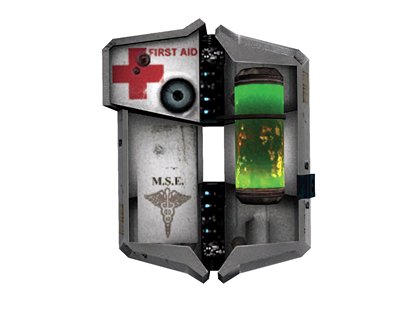Can you really rocket jump?
Healthpacks
In-game example: Half-Life 2. Those ever-present packages that mysteriously heal shotgun wounds.

Cyanoacrylate, aka superglue, is a hell of a thing. When you’re not secretly reassembling gran’s favorite Diana commemorative plate or using it to visit higher planes of consciousness, you could use it to stitch wounds together. In fact, it was used in the Vietnam War in spray form to staunch bleeding in serious wounds. You spray the edges of the wound and pinch them together for 30 seconds, slowing death. There are modern equivalents in use in Canada at the moment, with a view to replacing stitches: the speed it works at and the waterproofing helps stave off infections. None of this actually repairs the massive damage to your spleen, but with a few shots of tasty morphine and a healthy disregard for personal safety, there’s the basis of a game healthpack there.

HUD
In-game example: Ghost Recon: Advanced Warfighter. A system where handy information is projected onto a helmet or directly into the eyes.

That’s an easy one – it’s already happening. Military aviators have been using heads up displays for years, as an economical way of displaying data on the inside of windscreens. The pilot benefits from having a clear and easy way to simultaneously note the position of the horizon as well as other vital bits of information (We dunno, perhaps something like: “Drop bomb here!”). For the rest of us, head-mounted displays, such as the Liteye HMD, could provide a similar experience, but without the G-forces or the man-love. Actually, it’s an army product, so even if you do man-love you’d be required not to tell.

Bullet time
In-game example: FEAR. Speeding up your perception enough to see individual bullets fired from guns, and dodge them.

Do our brains really improve our perception of events when we’re in danger? Dr. David Eagleman at Baylor College of Medicine in Houston dropped volunteers backwards from 150 feet in the air, and asked them to estimate the length of their drop. Most guessed their drops were longer than was actually true. They then wore special watches called perceptual chronometers, which spun faster than the human eye could see and repeated the experiment. The idea was that if the brain did process the passing time so the body could react to the danger, the volunteers would be able to read the numbers on the watches. The results? They couldn’t. The current theory is that time distortion is a trick of memory: fear creates stronger memories which seem longer.

Weekly digests, tales from the communities you love, and more


